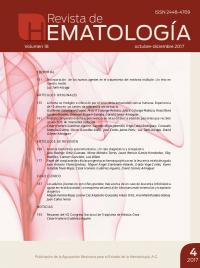Rev Hematol Mex. 2017 oct;18(4):161-167.
Gutiérrez-Aguirre CH, Mejía-Jaramillo G, Cantú-Rodríguez O, Mancías-Guerra C, González-Llano O, Jaime-Pérez JC, Tarín-Arzaga L, Gómez-Almaguer D
Servicio de Hematología, Universidad Autónoma de Nuevo León, Hospital Universitario Dr. José Eleuterio González, Monterrey, Nuevo León, México.
Resumen
ANTECEDENTES: el trasplante alogénico de células hematopoyéticas (alo-TCH) en algunos casos representa la mejor opción terapéutica contra neoplasias hematológicas; sin embargo, la edad del paciente puede ser un obstáculo. Desafortunadamente los pacientes de mayor edad tienen mayor incidencia de neoplasias hematológicas, como leucemia mieloide aguda o síndrome mielodisplásico. Hasta hace algunos años, el alo-TCH se ofrecía a pacientes jóvenes con buen estado general; sin embargo, con la aplicación de esquemas no mieloablativos y de intensidad reducida, esto cambió.
OBJETIVO: comparar la supervivencia de pacientes mayores y menores de 50 años que recibieron un alo-TCH con acondicionamiento de intensidad reducida.
MATERIAL Y MÉTODO: estudio retrospectivo en el que se analizaron los expedientes clínicos de pacientes que recibieron alo-TCH en el Hospital Universitario de Monterrey entre 2005 y 2015. Se agruparon en mayores y menores de 50 años de edad.
RESULTADOS: se incluyeron 93 pacientes, 47 menores y 46 mayores de 50 años, todos con ECOG < 2. Recibieron acondicionamiento de intensidad reducida (ciclofosfamida-flurarabina-busulfán o melfalán). En los menores de 50 años la mediana de las variables analizadas fue: células CD34+ trasfundidas 6×106/kg, recuperación mieloide 16 días, incidencia de enfermedad injerto contra huésped aguda/crónica (EICHa/EICHc): 29.8%/34%, y supervivencia a 1000 días de 54%. En los mayores de 50 años: células CD34+ transfundidas 6×106/kg, recuperación hematológica 15 días, incidencia de EICHa/EICHc 26.1%/13% y supervivencia a 1000 días de 49%. No se observó diferencia en la supervivencia (p = 0.4), cantidad de células trasplantadas, recuperación hematológica (p = 0.1), quimerismo (p = 0.82) o enfermedad injerto contra huésped aguda (p = 0.69) entre ambos grupos. Solo se observó diferencia en la incidencia de enfermedad injerto contra huésped crónica (p = 0.018).
CONCLUSIONES: la edad no fue un factor determinante en la supervivencia de este grupo de pacientes.
PALABRAS CLAVE: leucemia mieloide aguda, síndrome mielodisplásico, trasplante alogénico.
Comparative analysis of the survival in relation to age of patients receiving an alo-HCT with reduced intensity.
Rev Hematol Mex. 2017 October;18(4):161-167.
Gutiérrez-Aguirre CH, Mejía-Jaramillo G, Cantú-Rodríguez O, Mancías-Guerra C, González-Llano O, Jaime-Pérez JC, Tarín-Arzaga L, Gómez-Almaguer D
Servicio de Hematología, Universidad Autónoma de Nuevo León, Hospital Universitario Dr. José Eleuterio González, Monterrey, Nuevo León, México.
Abstract
BACKGROUND: Allo-transplantation of hematopoietic cells (alo-HCT) in some cases represents the best therapeutic option for hematological neoplasms; however, the age of the patient can be an obstacle. Unfortunately, older patients have a higher incidence of hematological neoplasms such as acute myeloid leukemia or myelodysplastic syndrome. Until a few years ago, alo-HCT was offered to young patients with good general condition; however, with the use of non-myeloablative and reduced intensity schemes this changed.
OBJECTIVE: To compare the survival of patients older than 50 years of age who received an alo-HCT with reduced intensity conditioning.
MATERIAL AND METHOD: A retrospective analysis of the clinical records of patients who received alo- HCT at the University Hospital of Monterrey between 2005 and 2015. They were grouped into younger or older than 50 years of age.
RESULTS: We included 93 patients, 47 younger and 46 older than 50 years, all with ECOG <2. They received reduced intensity conditioning (cyclophosphamide-fludarabine-busulfan or melphalan). The median of the analyzed variables was in younger than 50 years: CD34+ cells transfused 6×106/kg, myeloid recovery 16 days, incidence of acute graft-versus-host disease/chronic graft-versus-host disease (aGVHD/cGVHD): 29.8%/34%, and survival at 1000 days of 54%. In older than 50 years: transfused CD34+ cells 6×106/kg, haematological recovery 15 days, incidence of aGVHD/cGVHD 26.1%/13% and survival at 1000 days of 49%. There was no difference in survival (p = 0.4), number of transplanted cells, haematological recovery (p = 0.1), chimerism (p = 0.82) or aGVHD (p = 0.69) between both groups. Only difference in the incidence of cGVHD was observed (p = 0.018).
CONCLUSIONS: Age was not a determining factor in the survival of this group of patients.
KEYWORDS: leukemia, myeloid, acute; myelodysplastic syndrome; transplantation, allogeneic

